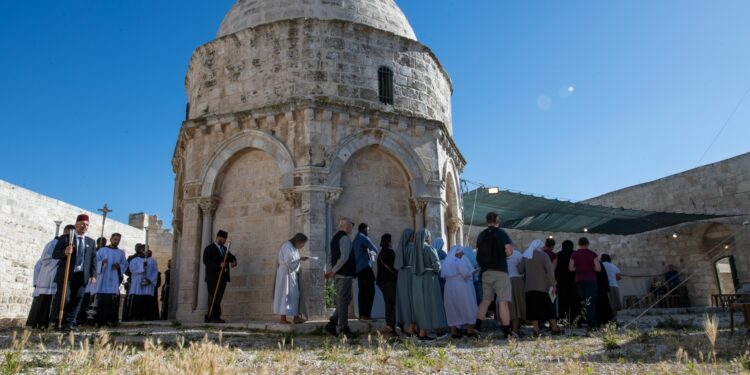Seeing buses of Christian pilgrims in Jerusalem has been rare since the war in Gaza broke out. However, for the feast of the Ascension, several buses arrived in the early hours of the night, especially from Nazareth and Galilee.
This is a pilgrimage launched about 30 years ago by the late Franciscan friar Jack Karam, and since then it has never stopped.
“We have come here to celebrate this feast together because it’s the only day when this place is open for us Christians,” Samia Abu Sini, who works at the French hospital in Nazareth managed by the Daughters of Charity of St. Vincent de Paul, told CNA. “They told us about this place and this celebration, and I wanted to come and visit.”
Don Prince Toussoun is a Salesian priest who is originally from Egypt but has lived in various places in the Holy Land, and for six years he has been in Nazareth in the parish dedicated to “Teenage Jesus.” On Wednesday night, he participated with a group of about 60 people in the vigil celebration.
“Every year we come for the Ascension,” he told CNA. “We pray during the bus journey, we stop here for the vigil celebration, then we celebrate the Mass at Dominus Flevit, and we spend some hours praying in the Holy Sepulcher.”
While waiting her turn to enter the Chapel of the Ascension in the middle of the night, Rawya Graisy from Nazareth shared with CNA her joy of being in this place for the first time. “I had heard about this church and wanted to see it,” she said. “We are here to pray to God. We pray to God to stop the war, to help all the people suffering because of it, and to grant us peace.”
At 8 o’clock in the morning, the faithful of Jerusalem returned to the site of the Ascension for the parish Mass. The solemn Mass of the Franciscans of the custody followed.
Among the attendees were also a group of Christians from the Melkite Parish of the Annunciation in Nazareth led by their pastor, Father Said Hashem. They also come to Jerusalem every year, contemplating the mystery of the Ascension in the place where it happened and visiting the most significant sites of the Holy City.

Already in the fourth century, pilgrims spoke of this place, which they called “Imbomon” (a term derived from Greek meaning “on the top” or “on the hill”). In her diary, the pilgrim Egeria reports that the community of Jerusalem gathered at the Imbomon on Palm Sunday, Maundy Thursday, every afternoon during Easter week, and on Pentecost Sunday.
(Story continues below)
Subscribe to our daily newsletter
With the conquest of Jerusalem in 1188, Saladin assigned “the land of the Mount of Olives” to two Muslim families and transformed it into an Islamic foundation. The central chapel of the church was converted into a mosque, but today it is not used for worship.
The Chapel of the Ascension is open to visitors and pilgrims throughout the year, but on Ascension Day Christians can celebrate the liturgy inside thanks to a concession granted to the Franciscans of the Custody of the Holy Land.
Credit: Source link





